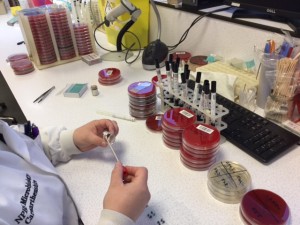W hen asking anyone to think about Healthcare Associated Infections and what actions they need to take, I ask them to apply 2 rules:
hen asking anyone to think about Healthcare Associated Infections and what actions they need to take, I ask them to apply 2 rules:
First: do no harm
Second: seek and take the positive action
First do no harm is not easy in dealing with infection because the actions we may need to take will often break this first rule and cause harm. Seriously? Yes, very seriously. Take the apparently simple act of prescribing an antibiotic. Antibiotics are not heat seeking pathogen missiles. While they seek out a specific bacterial target, that target will usually be generic to many bacteria and will kill any target containing bacteria indiscriminately. In other words, by default an antibiotic causes harm; inject or swallow an antibiotic and it immediately goes to work and starts killing bacteria.
It may come as a surprise to many but we are not alone. We are not a single entity. We may be one sentient mind but along with us comes 100,000,000,000,000 (that’s 100 trillion) harmonious bacteria, the vast majority of which live in our gastrointestinal tract. It is said that 50% of the dried weight of our faeces is bacteria (but who in their right mind did THAT experiment must be in a different place to me!) The point is, those antibiotics get to work killing these harmonious bacteria and upsetting the balance of our flora. While some may develop diarrhoea as a result of this insult and changes in the species balance, others may see no apparent effect. But unbeknown to us, we will select for bacteria that are resistant to the antibiotic we are eating (or being injected with).
But of course, antibiotics can have a very beneficial effect if someone has a bacterial infection. So then the second rule comes into play and argues that prescribing an antibiotic to treat a bacterial infection will help get rid of that infection. Important to recognise here of course that I specified bacterial infection. Many common infections will be viral and all an antibiotic will do then is cause harm by killing our harmonious bacteria. We also have to make the right choice of antibiotic, not least in our older population, who by the very nature of their age, are likely to have had more opportunities to meet antibiotics previously and the bacteria they will normally be carrying (which are the source of most infections they will meet) may have antibiotic resistance genes. Prescribers need to think about the age of their patients, previous antibiotic exposures, likely infection pathogens and conclude what will be their best guess first choice antibiotic, if they have to prescribe with a degree of urgency. They may be fortunate and have some previous microbiology reports to help guide them. They are a useful starting point but even then, the person may have acquired other bacteria since the time of that sample.
The same rules should be applied when using any medical device. If a patient presents urgently in a “crashed” state in A&E, one of the first actions the team will do is to get an intravenous line in place so they can have immediate access to give fluids and life saving drugs. Nobody would argue with that, least of all me.
But now apply the infection rules: first do no harm: immediately broken by breaching the first line of defence against infection, our intact skin. We again have a microflora residing harmlessly on our skin as we do in our gut (much lower numbers, of course). If we breach the skin somehow, we expose the deeper tissues to the bacteria on the surface and some of those bacteria may find the right conditions to multiply more readily and set up an infection. So out of choice, we do not walk around with intravenous lines in our arms on the off-chance that today we might become seriously ill and need to allow rapid access to our circulatory system. But if we do present in an emergency, the second rule comes into play and when seeking to save a life, inserting an IV line has a positive effect.
What is then important in either of these two scenarios in to continue to balance the two rules depending on the state of health and well-being of the patient. I always ask the clinicians to see if rule two has reduced in importance such that the risk of harm from the intervention if now greater that the positive effect: is it time to stop the antibiotics? Should the medical device be removed?
Medicine should be constantly juggling these two rules in many guises, not just in infection and of course, this all adds to the complexity of what we are expecting our clinicians to deal with. What we as microbiologists have been doing is seeking to help guide our clinical colleagues in when to prescribe and what to prescribe from an antibiotic perspective, give guidance on interpretation of the microbiology and aim to provide triggers for action or inaction and so steer the response to infection in such a way that we will see the burden of infection reduce over the coming years and months, as outlined in the health board paper, which set a new direction of travel for infection management across the Hywel Dda University Health Board area.
Leave a Reply